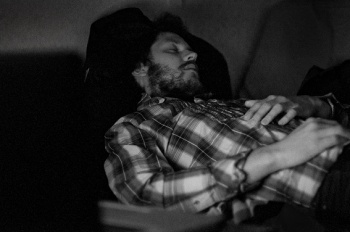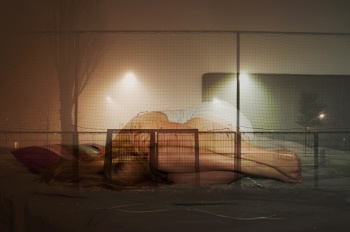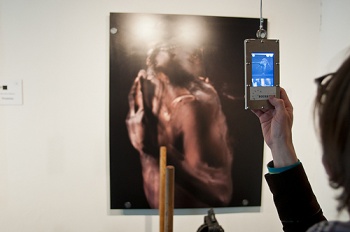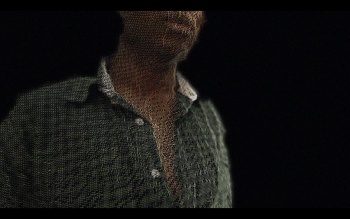Janis - combination of description: Difference between revisions
No edit summary |
No edit summary |
||
| (4 intermediate revisions by the same user not shown) | |||
| Line 1: | Line 1: | ||
[[File:slothful_dreams.jpeg | thumb | 350px | right | none| My slothful dreams]] | |||
In my previous practice I was obsessed with different visual experiments, editing and postproduction techniques. I came up with short fictional stories that I was dreaming about or simply imagining. I was curious how can I visualize those stories by using photographs or moving images. | |||
The video "My slothful dreams" was created in an experimental process as a playful visualization of a recent dream. A tired man with a big bushy beard stands in the bathroom and looks at himself in a mirror. He feels ugly. He wants to shave the beard but he is too shiftless and lazy to do it. He takes off his shirt looks around and suddenly instead of taking a razor he has an idea to try to shave off the beard with his nails and finger tips. He tries to touch his face and the finger tips are becoming razor sharp as well as the nails. The surreal and absurd situation contrasts with a dash of humor within the story line where our reality goes hand by hand with our dreams. The dream translated it self during the editing process and the short storyline established towards laziness and unreal wish theme about avoidance and imagination. | |||
By making "My slothful dreams", I was interested to explore and visualize the absurd situation that I saw in my dream. As the outcome I made an stop motion image sequence that displays the fictional reality. | |||
[[Image:1_Janis Klimanovs.jpg | thumb | 350px |right|none | Ambiguous space ]] | |||
After that I continued with the dream theme and the explorations of the digital lens based media and experiments with digital images. I was referring to the several exposure technique by overlying images one on each other. I was mixing together several visuals, women characters who are lost in their space and nature landscapes. I was trying to construct the connection and search for an ambiguous space in-between where the character and the two environments would some how fit together. | |||
I was pleased by the fact, how two different spaces can merge together and create a third one, construct an photographical, even photorealistic, aesthetically nice imagination. | |||
In the following term I was interested to investigate how a software can generate visual information in between, knowing two coordinates and creating the third one. | |||
The visual material consisted from a lot of still images, the sequence was a bit reformed and processed on a computer by using after effects software. There were two results, an high quality, large scale printed image and a fast moving image sequence, both displaying a digitally generated movement. The motion was corrupted by the software, in a way representing time and deforming the natural body moves. | |||
The video is the hidden augmented world of the work, it can be revealed when a smartphone is directed at the photograph. On the digital screen the hidden reality unfolds engaging the spectator and resulting in a strong connection with the photograph it self. | |||
Again, it explored the boundaries of lens based medium, unfolded another way of a visual interpretation and raised a question why the post-photographical qualities are interesting in nowadays? It is yet another way of manipulating reality, another way of experiencing it by using these contemporary tools. | |||
At the moment I am questioning myself, what qualities from these experiments I can borrow and put into my visual language grammar section, what does it add to my working methodology? | |||
[[Image: boerhaave exhibition 4.jpg | thumb | 350px |right|none | On the way ]] | |||
In the last trimester of the first year, I merged my ideas with Javier Lloret and we created the project "Human Stock". It is a video presentation about a fake media company which actually does not exist. In the video actors are describing the utopian plans about the platform and how it is going to change the visual media industry. | |||
The platform is offering an online stock library of 3D photorealistic visuals of real human beings. Customers from the industry can browse an online store, purchase and download any of the 3D model stock visuals. It has a potential to create wholly new markets and employment opportunities, and change the visual language of perceiving images. | |||
Conversely, the Human Stock is offering to anyone the opportunity to have their body digitized for the 3D stock library, using the automated, easy-to-use 3D full body scanner booth. Each model/supplier can earn a fixed percentage of the revenue generated with each download and use. | |||
The video advertisement consists of interviews in which the founders explain how it works and some of the users are giving feedback of their experiences. It is a trailer/mockumentary which gives a short description about what Human stock is and how it works. | |||
[[Image: human stock1.jpg | thumb | 350px | right |none | Human stock]] | |||
The | The fake company has been created as an inspiration by Apple and other powerful companies and service platforms, admiring their aims and products. | ||
Sometimes they are producing utopian things, and representing them in an even more bizarre level, they are real but kind of "on the edge" with the reality, revolutionary as they say. Promising one thing, but behind it stands something else. For example a track for online marketing tools. | |||
Any how, it is interesting to see how people are reacting to these kind of revolutionary services and products. | |||
Also, what kind of questions are raised after seeing Human Stock "proposal"? | |||
Do people believe that it is a real company or just a fiction? How far can I go to make people believe and convince them that its harmless? | |||
Do people understand that it is a fiction or it does not matter? | |||
With the technology that is out there some company could actually provide this service. Would people use it and do not think about the consequences? For example, that it is possible to loose the track of their personal digital image and the way how and where it has been used? | |||
How much control do we have currently with the real online services where we share our images and information with others? | |||
Latest revision as of 21:28, 20 November 2012
In my previous practice I was obsessed with different visual experiments, editing and postproduction techniques. I came up with short fictional stories that I was dreaming about or simply imagining. I was curious how can I visualize those stories by using photographs or moving images.
The video "My slothful dreams" was created in an experimental process as a playful visualization of a recent dream. A tired man with a big bushy beard stands in the bathroom and looks at himself in a mirror. He feels ugly. He wants to shave the beard but he is too shiftless and lazy to do it. He takes off his shirt looks around and suddenly instead of taking a razor he has an idea to try to shave off the beard with his nails and finger tips. He tries to touch his face and the finger tips are becoming razor sharp as well as the nails. The surreal and absurd situation contrasts with a dash of humor within the story line where our reality goes hand by hand with our dreams. The dream translated it self during the editing process and the short storyline established towards laziness and unreal wish theme about avoidance and imagination.
By making "My slothful dreams", I was interested to explore and visualize the absurd situation that I saw in my dream. As the outcome I made an stop motion image sequence that displays the fictional reality.
After that I continued with the dream theme and the explorations of the digital lens based media and experiments with digital images. I was referring to the several exposure technique by overlying images one on each other. I was mixing together several visuals, women characters who are lost in their space and nature landscapes. I was trying to construct the connection and search for an ambiguous space in-between where the character and the two environments would some how fit together. I was pleased by the fact, how two different spaces can merge together and create a third one, construct an photographical, even photorealistic, aesthetically nice imagination.
In the following term I was interested to investigate how a software can generate visual information in between, knowing two coordinates and creating the third one. The visual material consisted from a lot of still images, the sequence was a bit reformed and processed on a computer by using after effects software. There were two results, an high quality, large scale printed image and a fast moving image sequence, both displaying a digitally generated movement. The motion was corrupted by the software, in a way representing time and deforming the natural body moves. The video is the hidden augmented world of the work, it can be revealed when a smartphone is directed at the photograph. On the digital screen the hidden reality unfolds engaging the spectator and resulting in a strong connection with the photograph it self.
Again, it explored the boundaries of lens based medium, unfolded another way of a visual interpretation and raised a question why the post-photographical qualities are interesting in nowadays? It is yet another way of manipulating reality, another way of experiencing it by using these contemporary tools. At the moment I am questioning myself, what qualities from these experiments I can borrow and put into my visual language grammar section, what does it add to my working methodology?
In the last trimester of the first year, I merged my ideas with Javier Lloret and we created the project "Human Stock". It is a video presentation about a fake media company which actually does not exist. In the video actors are describing the utopian plans about the platform and how it is going to change the visual media industry.
The platform is offering an online stock library of 3D photorealistic visuals of real human beings. Customers from the industry can browse an online store, purchase and download any of the 3D model stock visuals. It has a potential to create wholly new markets and employment opportunities, and change the visual language of perceiving images.
Conversely, the Human Stock is offering to anyone the opportunity to have their body digitized for the 3D stock library, using the automated, easy-to-use 3D full body scanner booth. Each model/supplier can earn a fixed percentage of the revenue generated with each download and use.
The video advertisement consists of interviews in which the founders explain how it works and some of the users are giving feedback of their experiences. It is a trailer/mockumentary which gives a short description about what Human stock is and how it works.
The fake company has been created as an inspiration by Apple and other powerful companies and service platforms, admiring their aims and products. Sometimes they are producing utopian things, and representing them in an even more bizarre level, they are real but kind of "on the edge" with the reality, revolutionary as they say. Promising one thing, but behind it stands something else. For example a track for online marketing tools.
Any how, it is interesting to see how people are reacting to these kind of revolutionary services and products. Also, what kind of questions are raised after seeing Human Stock "proposal"? Do people believe that it is a real company or just a fiction? How far can I go to make people believe and convince them that its harmless? Do people understand that it is a fiction or it does not matter?
With the technology that is out there some company could actually provide this service. Would people use it and do not think about the consequences? For example, that it is possible to loose the track of their personal digital image and the way how and where it has been used? How much control do we have currently with the real online services where we share our images and information with others?




